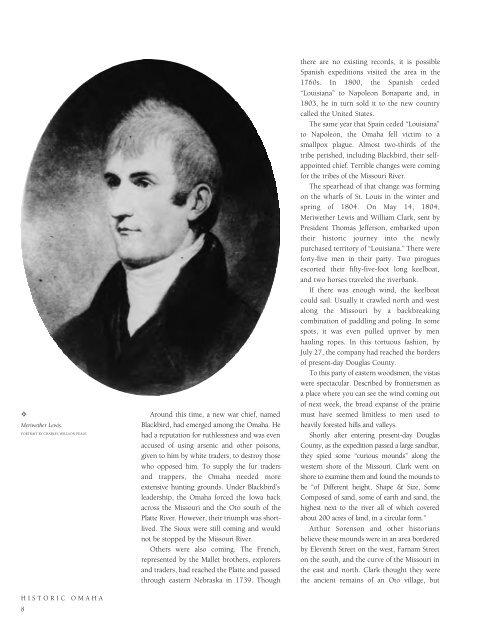Historic Omaha
An illustrated history of Omaha and the Douglas County area, paired with the histories of companies, families and organizations that make the region great.
An illustrated history of Omaha and the Douglas County area, paired with the histories of companies, families and organizations that make the region great.
You also want an ePaper? Increase the reach of your titles
YUMPU automatically turns print PDFs into web optimized ePapers that Google loves.
✧<br />
Meriwether Lewis.<br />
PORTRAIT BY CHARLES WILLSON PEALE.<br />
HISTORIC OMAHA<br />
8<br />
Around this time, a new war chief, named<br />
Blackbird, had emerged among the <strong>Omaha</strong>. He<br />
had a reputation for ruthlessness and was even<br />
accused of using arsenic and other poisons,<br />
given to him by white traders, to destroy those<br />
who opposed him. To supply the fur traders<br />
and trappers, the <strong>Omaha</strong> needed more<br />
extensive hunting grounds. Under Blackbird’s<br />
leadership, the <strong>Omaha</strong> forced the Iowa back<br />
across the Missouri and the Oto south of the<br />
Platte River. However, their triumph was shortlived.<br />
The Sioux were still coming and would<br />
not be stopped by the Missouri River.<br />
Others were also coming. The French,<br />
represented by the Mallet brothers, explorers<br />
and traders, had reached the Platte and passed<br />
through eastern Nebraska in 1739. Though<br />
there are no existing records, it is possible<br />
Spanish expeditions visited the area in the<br />
1760s. In 1800, the Spanish ceded<br />
“Louisiana” to Napoleon Bonaparte and, in<br />
1803, he in turn sold it to the new country<br />
called the United States.<br />
The same year that Spain ceded “Louisiana”<br />
to Napoleon, the <strong>Omaha</strong> fell victim to a<br />
smallpox plague. Almost two-thirds of the<br />
tribe perished, including Blackbird, their selfappointed<br />
chief. Terrible changes were coming<br />
for the tribes of the Missouri River.<br />
The spearhead of that change was forming<br />
on the wharfs of St. Louis in the winter and<br />
spring of 1804. On May 14, 1804,<br />
Meriwether Lewis and William Clark, sent by<br />
President Thomas Jefferson, embarked upon<br />
their historic journey into the newly<br />
purchased territory of “Louisiana.” There were<br />
forty-five men in their party. Two pirogues<br />
escorted their fifty-five-foot long keelboat,<br />
and two horses traveled the riverbank.<br />
If there was enough wind, the keelboat<br />
could sail. Usually it crawled north and west<br />
along the Missouri by a backbreaking<br />
combination of paddling and poling. In some<br />
spots, it was even pulled upriver by men<br />
hauling ropes. In this tortuous fashion, by<br />
July 27, the company had reached the borders<br />
of present-day Douglas County.<br />
To this party of eastern woodsmen, the vistas<br />
were spectacular. Described by frontiersmen as<br />
a place where you can see the wind coming out<br />
of next week, the broad expanse of the prairie<br />
must have seemed limitless to men used to<br />
heavily forested hills and valleys.<br />
Shortly after entering present-day Douglas<br />
County, as the expedition passed a large sandbar,<br />
they spied some “curious mounds” along the<br />
western shore of the Missouri. Clark went on<br />
shore to examine them and found the mounds to<br />
be “of Different height, Shape & Size, Some<br />
Composed of sand, some of earth and sand, the<br />
highest next to the river all of which covered<br />
about 200 acres of land, in a circular form.”<br />
Arthur Sorenson and other historians<br />
believe these mounds were in an area bordered<br />
by Eleventh Street on the west, Farnam Street<br />
on the south, and the curve of the Missouri in<br />
the east and north. Clark thought they were<br />
the ancient remains of an Oto village, but
















